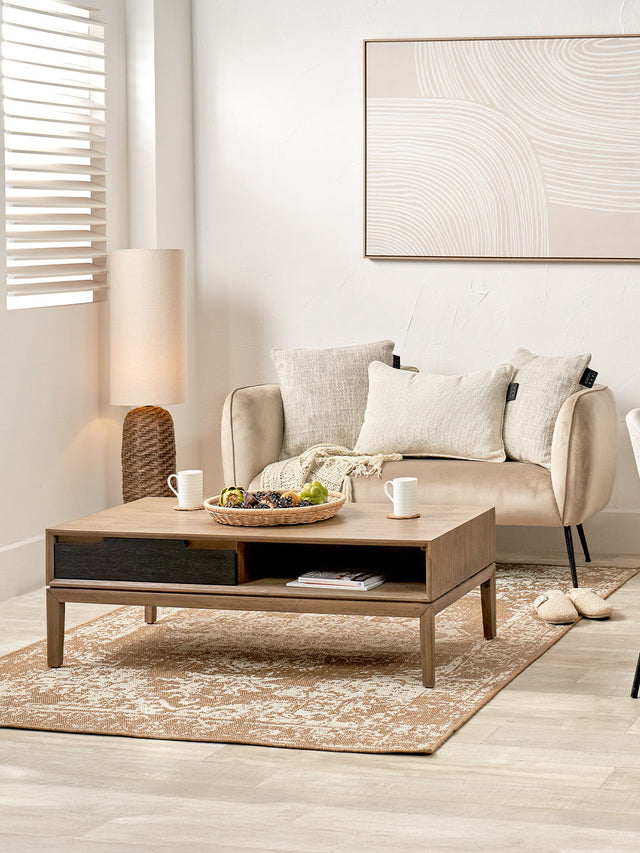The Art of Layering Natural Textures
The Art of Layering Natural Textures
There is a quiet elegance in a room that feels layered, tactile, and inviting. The secret often lies in how textures are combined. From wool and linen to wood and stone, the natural materials you choose and how you bring them together can completely transform the atmosphere of a space.
Layering natural textures is central to the Autumn Edit. It is what gives a room warmth and depth without the need for bold colours or overly decorative details. Instead, the character comes from contrast. The soft against the sturdy, the smooth beside the rough, the light paired with the dark.
In this article, we explore the art of layering natural textures in your home. You will discover how to mix fabrics and finishes, how to balance rustic with refined, and how to create interiors that feel lived-in yet timeless.

Begin with Fabrics
Fabrics are the easiest way to bring natural texture into a room. They are also the most flexible since they can be layered, swapped, and updated with the seasons. Think of them as the foundation for your interior’s tactile story.
Begin with wool. It adds warmth, softness, and a touch of rustic charm. Throws, blankets, and cushions in wool instantly make a room feel more inviting, especially during the cooler months.
Next, bring in linen. Its relaxed, slightly crumpled quality balances the heavier feel of wool. Linen curtains, table runners, or cushion covers can lighten the overall scheme and introduce a breezy, effortless feel.
Finally, use cotton as a grounding layer. It is versatile, hard-wearing, and easy to maintain, which makes it perfect for everyday essentials such as slipcovers, bedding, or textiles around the home.
The beauty lies in the contrast. A heavy wool throw on a linen armchair or a crisp cotton sheet beneath a soft wool blanket creates instant comfort and visual depth. When combined, these fabrics add life to a space without overwhelming it.

Bring in Natural Surfaces
Beyond fabrics, the surfaces you choose are key to creating depth and interest. Wood, stone and rattan each bring their own unique qualities and combine beautifully in a farmhouse or English country setting.
Wood should be your anchor. Oak, ash, or reclaimed timber instantly introduce warmth and character. A solid sideboard, dining table, or coffee table in natural wood feels timeless and grounds the room.
Stone adds weight and authenticity. Whether in flooring, a fireplace surround, or decorative pieces like vases, its cool, tactile quality balances the warmth of wood and fabric. Even a small detail, such as a stoneware bowl or platter, can make a subtle difference.
Rattan is lighter and more playful. Baskets, lampshades, or the back of a chair bring a handwoven charm that softens the sturdier elements. It works especially well when used sparingly to add variation.
When layered together, these natural surfaces create balance. A wooden sideboard with a stone vase and a rattan basket beside it will always feel inviting, honest, and lived-in.

Mix Rough and Smooth Finishes
Contrast is the heart of layered interiors. Pairing rough textures with smooth surfaces adds interest and keeps a room from feeling flat or one-dimensional.
For example, a slightly weathered wooden table looks even richer when paired with a polished ceramic vase. A woollen throw draped over a sleek leather chair softens its edges while highlighting the difference between materials.
Think beyond furniture. Rough linen cushions on a smooth cotton sofa, a stone planter on a polished wooden shelf, or a textured rug over floorboards all work to create subtle layers that delight the eye and invite touch.
The goal is harmony through contrast. Each texture should complement the others, creating a space that feels thoughtfully curated but effortlessly comfortable.

Add Seasonal and Personal Accents
The final layer of natural texture comes from smaller accents that reflect both the season and your personality. These details make a space feel lived-in and uniquely yours.
In autumn, think dried flowers, pinecones, or a simple wooden bowl of fruit. In spring, fresh blooms, soft linen throws, and lighter woven baskets can refresh the room. Rotating accents with the seasons keeps your home feeling relevant and cosy year-round.
Personal items also contribute texture. A well-loved book, a hand-thrown ceramic vase, or a woven family heirloom adds layers of meaning and tactile interest. These touches make the home feel collected over time rather than staged.
By combining seasonal accents with personal pieces, you create a room that is inviting, texturally rich, and entirely your own.

Layering natural textures is what transforms a house into a home. By combining fabrics, surfaces, finishes, and personal touches, you create depth, warmth, and character in every room. Each layer from a woollen throw to a hand-thrown vase contributes to a space that feels inviting, lived-in, and timeless.
The Autumn Edit is all about celebrating these textures with thoughtful, effortless styling. Embrace contrast, mix materials, and let each detail tell a story. The result is a home that embodies the charm and serenity of the English countryside.

